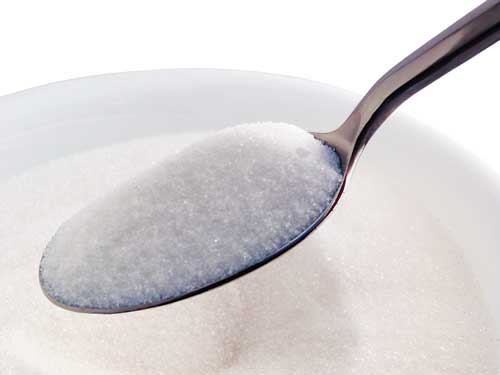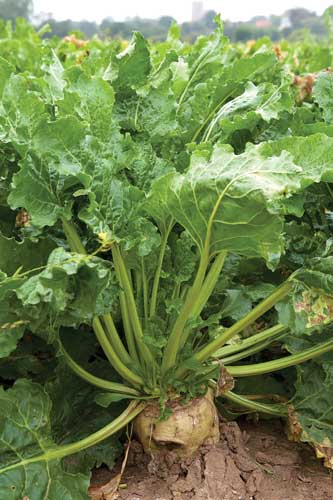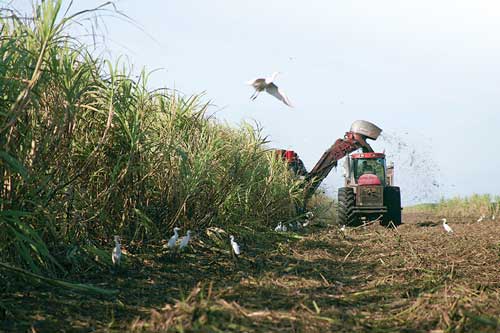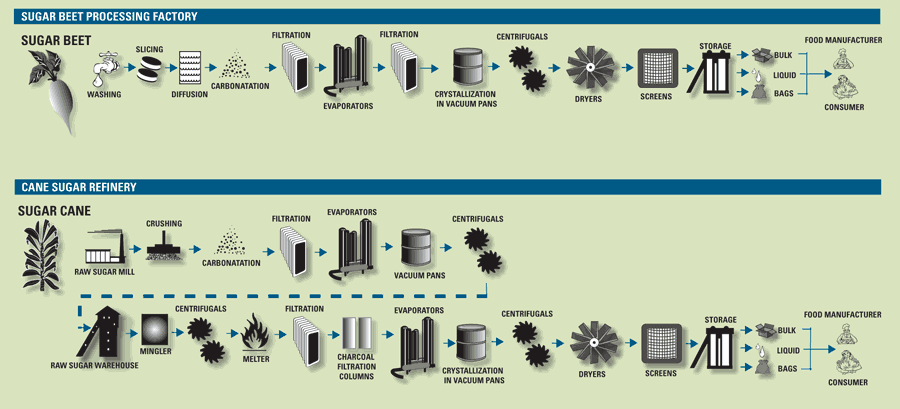More than a Spoonful of Sugar
FOOD SAFETY & QUALITY
 A spoonful of sugar helps the medicine go down, according to the song in the movie Mary Poppins, but it also provides energy (15 calories per teaspoon) and has many other functions, ranging from satisfying people’s desire for sweetness to helping preserve foods. Sugar (sucrose) is a disaccharide of glucose and fructose that occurs naturally in fruits and vegetables; the highest concentration is in sugar cane and sugar beet. The Codex Alimentarius Commission defines white sugar as purified and crystallized sucrose with a purity no lower than 99.7%.
A spoonful of sugar helps the medicine go down, according to the song in the movie Mary Poppins, but it also provides energy (15 calories per teaspoon) and has many other functions, ranging from satisfying people’s desire for sweetness to helping preserve foods. Sugar (sucrose) is a disaccharide of glucose and fructose that occurs naturally in fruits and vegetables; the highest concentration is in sugar cane and sugar beet. The Codex Alimentarius Commission defines white sugar as purified and crystallized sucrose with a purity no lower than 99.7%.
More than 120 million tons of sucrose is produced per year in 121 countries, with about 70% produced from sugar cane and 30% from sugar beet. Among the world’s largest sugar producers is the United States, where sugar cane accounts for about 45% of the total sugar produced and sugar beet for about 55%. The U.S. Dept. of Agriculture’s Economic Research Service (USDA-ERS) attributes production increases over the past three decades to substantial investment in new processing equipment, adoption of new technologies, use of improved crop varieties, and expansion of acreage.
Cane Sugar Production
Sugar cane (Saccharum officinarum) is a tall perennial grass grown in tropical and semitropical climates. In the United States, it is grown in Florida, Louisiana, Hawaii, and Texas. The sugar content is typically about 10% by weight but depends on the variety, location, and seasonal variation. Sugar cane is rarely commercially grown from seeds; harvested stalks are instead buried horizontally in fields. The cane is generally harvested annually. If the cane is harvested manually, the field is first burned to help remove the leaves (the cane may also be burned if it is harvested mechanically). Mechanical harvesters strip the leaves and cut the cane. Once the sugar cane is harvested, it is transported to a nearby sugar mill where it is washed and shredded, then pressed by high-pressure rollers to extract most of the juice. The remaining fiber, called bagasse, is used as fuel, and the juice undergoes a further milling process before being crystallized to become raw sugar, which is transported to a sugar refinery where it undergoes a further series of processing steps.
In the first step, called affination, raw sugar, which is approximately 96%–98% sucrose crystals covered by a thin film of molasses, is mixed with a warm saturated sugar solution, and the resulting mixture, called magma, is centrifuged to separate the crystals from the syrup, removing most impurities. The raw sugar is then dissolved in water (i.e., melted) to create a sugar liquor. Since the liquor still contains some color, fine particles, gums, resins, and other non-sugars, it is clarified using one of two standard methods. In the method called carbonatation, calcium hydroxide (milk of lime) and carbon dioxide are added to the liquor, producing calcium carbonate that precipitates and captures the impurities. In the other method, called phosphatation, phosphoric acid, milk of lime, and a flocculent polymer are added to the liquor, producing a calcium phosphate precipitate. In both methods, the precipitate containing the impurities is subsequently removed by filtration or by air flotation in frothing clarifiers.
Next, the liquor is passed through activated carbon, natural charcoal, or ion-exchange resin to remove any remaining color, and the decolorized liquor is concentrated in an evaporator under vacuum to increase the sugar content from about 63% to more than 73% by weight. The concentrated liquor is added to vacuum crystallization pans to evaporate more of the water until conditions are right for crystal formation, at which point some fine sugar crystals are added to initiate crystal formation. The resulting sugar crystals are separated from the mother liquor via batch centrifugation and dried in rotary dryers using forced hot air. The crystals are then classified by size by using sieves and packed or stored.
Since the liquor left over from the preparation of the crystals and the washings from the affination stage both still contain some sugar, they are further processed to produce a sweet by-product called refiners’ molasses, which is usually made into cattle food or used to produce alcohol.
 Beet Sugar Production
Beet Sugar Production
Sugar beet (Beta vulgaris) is a biennial root crop grown in temperate climates and harvested annually. In the United States, it is grown in California, Colorado, Idaho, Michigan, Minnesota, Montana, Nebraska, North Dakota, Oregon, Washington, and Wyoming. The sugar content is typically 16%–18% by weight but depends on the variety, location, and seasonal variation. The USDA-ERS says that a recent development has been the introduction of genetically modified seed varieties, accounting for more than 95% of planted areas.
Whereas cane sugar is made in two stages, first at the harvesting location to produce raw sugar and second at a factory for further refining, beet sugar is made in only one stage. When the beets are ready for harvesting, a mechanical defoliator removes the leaves and top of the beet and a pinch wheel machine pulls the beet root from the soil. The beets are washed and sliced into thin strips called cossettes to increase the surface area available for the next step, which is extraction of the sugar by countercurrent diffusion with hot water. The pressed pulp is then dried and used for livestock feed and other products, and the sugar solution, called raw juice, undergoes carbonatation or phosphatation, as in cane sugar processing.
In a subsequent step called sulfitation or third saturation, sulfur dioxide is added to the clear juice from the carbonatation step to inhibit the Maillard reaction between sugar and residual amino acids in the juice during heating, which would produce a dark brown color. The juice, now referred to as thin juice, is pumped through a series of multiple-effect evaporators to increase the sugar concentration from about 12%–18% solids to 61%–72%. The resulting thick juice or standard liquor is concentrated by boiling in vacuum pans with continuous addition of standard liquor until the sugar saturation point is reached, when fine crystals of sugar are added to initiate crystallization. Then the mixture of crystals and syrup from which the crystals were grown, called massecuite, is centrifuged to separate the crystals from the syrup. The subsequent steps are the same as in cane sugar processing.
The syrup separated from the massecuite is molasses, which contains about 50% of the original sucrose in the beet and about 60% of the soluble non-sugars originally extracted from the beet. Beet molasses is non-edible due to high salt and other non-sugar content and therefore is not used for production of brown sugar. Most of the beet molasses in the United States is further processed by chromatographic separation, which removes about 90% of the sugar in the molasses. Two streams are produced: one stream is a high-sucrose liquor that is crystallized into white refined sugar, and the other, consisting primarily of salts and amino acids, is concentrated through evaporation and sold as animal feed. A small fraction of the non-chromatographically separated molasses is used for alcohol production.
--- PAGE BREAK ---
Types of Products
Whether from sugar cane or beet, granulated white sugar is the starting material for the production of other refined sugar products. It is the sugar used by consumers (generally called fine or extra fine granulated sugar) and the food industry. It is available in many different crystal sizes, each providing functional characteristics appropriate for a specific use. Fruit sugar has a slightly finer, more uniform crystal size for use in dry mixes. Designed for the baking industry, bakers special sugar is the finest granulated sugar.
Powdered sugar is granulated white sugar that has been pulverized or milled and mixed with about 3% cornstarch to prevent caking. It is generally available in three degrees of fineness (6X, 10X, and 12X; the higher the number, the finer the product). Confectioners sugar is fine powdered sugar, and fondant and icing sugar are the finest. Coarse sugar, which is boiled from the same liquor used to make regular granulated sugar, has a larger crystal size than regular sugar, making it highly resistant to color change or natural breakdown into fructose and glucose (inversion) at cooking and baking temperatures. Sanding sugar is a larger crystal sugar used mainly in the baking and confectionery industries.
Brown sugar is produced in two ways, boiling or painting (coating). In the boiling process, the mother liquor separated from white sugar crystals is mixed with dark-colored refinery syrups and heated to caramelize the sugar and create the typical brown color and associated flavor throughout the entire sugar crystal. In the painting process, white granulated sugar is coated with cane sugar molasses. The difference between light brown sugar and dark brown sugar is the amount of molasses.
Demerara sugar is a light brown sugar with large, slightly sticky crystals. Raw sugar is a light-brown coarse granulated sugar resulting from the evaporation of clarified sugar cane juice. Turbinado sugar is a light-brown raw sugar that has been washed to remove some of the surface molasses; Sugar in the Raw is a brand of turbinado sugar. Muscovado or Barbados sugar is a very dark brown sugar with a strong molasses flavor and slightly coarser and stickier crystals than regular brown sugar.
Liquid sugar is granulated white sugar that has been dissolved in potable water or in sugar liquor from the refining process after the ion-exchange step; it is used in formulations that require sugar in liquid form. Amber liquid sugar is darker in color and can be used in foods where brown color is desired. Invert sugar is a liquid sugar for which sucrose has been split (inverted) into its two component sugars: glucose and fructose. Since fructose is sweeter than glucose and sucrose, invert sugar is sweeter than white sugar. Different mixtures of sucrose and invert sugar are used by food manufacturers to retard the crystallization of sugar and to retain moisture in packaged foods.
Co-crystallized sugars are blends of various syrups from the sugar refining process that are heated to extreme supersaturation and then allowed to flash cool. This results in the creation of amorphous crystals that can trap separately added ingredients such as honey, molasses, brown sugar syrup, invert sugar, and maltodextrin. Sugar cubes and colored sugars are other forms of sugar on the market.
 ASR Group
ASR Group
Domino Foods Inc., Iselin, N.J. (dominosugar.com), is the largest marketer of refined cane sugar in the United States. It is one of several companies belonging to the largest cane sugar refiner in the world, ASR Group, West Palm Beach, Fla. (asr-group.com), which also includes American Sugar Refining Inc., C&H Sugar Co., Redpath Sugar, and Tate & Lyle Sugars. Each of the company’s U.S. refineries processes up to 8 million pounds of raw sugar per day. Domino Foods also distributes the Florida Crystals brand.
For consumers, Domino Foods markets Domino Sugar white granulated sugar, superfine granulated sugar, bakers special granulated sugar, Domino Dots & Tablets and C&H Cubes for coffee service, light and dark brown sugar, powdered/confectioners/icing sugar, Brownulated granulated brown sugar, Honey Granules, Sugar N’ Cinnamon, demerara sugar, and natural and organic evaporated cane juice (sold under the Florida Crystals brand). S. Michael Burchell, director of quality management for ASR Group, said that the company’s refinery in Florida is the only domestic producer of organic cane sugar and that the company makes the majority of its brown sugar in the United States by the boiling method.
For food industry use, the company markets granulated sugars in a wide variety of particle sizes for specific applications. These include bakers special; extra fine granulated; very large, coarse sugar crystals (some as large as 2 mm) designed for specific applications such as candy, cereal, and baked goods toppings; coarse sugar crystals that have been colored for use as toppings; light, medium, and dark brown sugars; powdered/ confectioners/icing sugar with and without corn starch (6X, 10X, and 12X); pulverized sugar with maltodextrin for use as glaze; pharmaceutical-grade sugars (granulated, powdered, and compressible); natural and organic evaporated cane juice; liquid sugar; and medium invert (50%) and invert (>90%) syrups. Burchell said that new varieties of cane sugar are developed through breeding of existing varieties rather than through genetic engineering, which means that many of the products can qualify for non-GMO verification.
Burchell said that many quality tests are conducted. The raw sugar purchase price is determined by a number of factors, but the most important one is the purity (sucrose content) of the raw sugar. This is measured using a polarimeter specially designed for sugar analysis so that it displays the result in percent sucrose rather than in degrees of rotation. This purity measurement is also used for brown sugars, molasses, and refinery syrups. Once sugar is dissolved, the percent sucrose (Brix) of the solution is routinely measured throughout the refining process by refractometer.
Color is measured by absorbance in solution and by optical reflectance. The absorbance of a fixed weight of sugar dissolved in water is measured using a spectrophotometer, and a numerical value is calculated following the international standard for color set by the International Commission for Uniform Methods of Sugar Analysis method. Optical reflectance of crystals is measured by colorimeter, primarily for brown sugars and some specialty products for which appearance is key.
Other analyses that are conducted on finished products include granulation size by sieve or particle-size analyzer, moisture content by high-resolution infrared moisture balance, inorganic material (ash, the natural minerals present in the sugar cane) by conductivity, turbidity by turbidimeter, corn starch content in powdered and icing sugars by turbidimeter or spectrophotometer, and invert sugar by manual titration or biochemistry analyzer. Burchell said that sugar’s crystallization and purification processes, along with its extremely low moisture content and water activity, precludes microbial growth, which is why it has been used as a preservative for centuries.
--- PAGE BREAK ---
Amalgamated Sugar Co.
Amalgamated Sugar Co., Boise, Idaho (amalgamatedsugar.com), the second-largest refiner and processor of sugar from sugar beets in the United States, produces approximately 1.5 million tons of sugar annually. Mike Fowers, quality assurance director at Amalgamated Sugar, said that the company produces granulated sugar, powdered sugar, and both dark and light brown sugars for the retail market as well as five granulated sugars for the industrial market characterized by particle size: industrial coarse, fine granulated, extra fine granulated, gel gran, and bakers special. The company’s powdered sugar is produced by pulverizing granulated sugar crystals to a desired particle size and adding up to 5% corn starch as a flow agent since the powdered sugar is very hygroscopic.
Fowers said that the company’s brown sugar is produced by enrobing sugar crystals with a syrup composed of liquid invert sugar and cane molasses. The characteristic flavor, texture, and color are controlled by the amount of enrobing syrup applied. The granulated sugars differ in particle-size distribution, but all other characteristics (nutritional value, color, etc.) are the same. The sugar used for the powdered sugar and brown sugar is identical to the granulated sugar, and particle size and additives (corn starch, cane molasses, etc.) are the only distinguishing characteristics. The company also produces liquid sugar, an aqueous solution of sugar produced to a specified solids content. Two types are based on solids content, and a third type, medium invert, is chemically inverted to contain equal amounts of sucrose, glucose, and fructose.
 Fowers said that the company performs more than 300 quality control tests per hour on in-process materials to optimize quality and recovery of the sugar. The final crystallized sugar is evaluated for color, ash (soluble salts, typically less than 0.02%), moisture, particle-size distribution, purity, and other customer-specific requirements. Color is determined by spectrophotometer, ash by conductivity, moisture by weight of moisture loss upon drying, particle-size distribution by certified standard sieves, starch content of powdered sugar by polarimeter, and purity by infrared spectroscopy. The company also uses gas chromatography, liquid chromatography, ion chromatography, and atomic absorption spectroscopy, depending on specific customer requirements. Fowers said that near-infrared spectroscopy is being used to determine characteristics of particular sugars.
Fowers said that the company performs more than 300 quality control tests per hour on in-process materials to optimize quality and recovery of the sugar. The final crystallized sugar is evaluated for color, ash (soluble salts, typically less than 0.02%), moisture, particle-size distribution, purity, and other customer-specific requirements. Color is determined by spectrophotometer, ash by conductivity, moisture by weight of moisture loss upon drying, particle-size distribution by certified standard sieves, starch content of powdered sugar by polarimeter, and purity by infrared spectroscopy. The company also uses gas chromatography, liquid chromatography, ion chromatography, and atomic absorption spectroscopy, depending on specific customer requirements. Fowers said that near-infrared spectroscopy is being used to determine characteristics of particular sugars.
Microbiological analysis is performed on sugar as it is produced and transferred to storage. The same analysis is completed on each lot of sugar as it is shipped to the customer or packaged. The analysis includes enumeration of aerobic mesophilic bacteria, yeast, molds, anaerobic thermophilic spore-forming bacteria, and flat-sour thermophilic organisms. Heat-resistant mold and bacteria require additional testing for those specific species. The water activity of sugar is below 0.3 and therefore inhibits the proliferation of pathogenic microorganisms. All of the sugar produced by the company meets canners’ and bottlers’ specifications in addition to being pathogen-free. Analysis is also done periodically for heavy metal, pesticide, and herbicide residues. Specific lots are also tested and certified to meet pharmaceutical specifications.
Advances and Challenges
ASR Group’s Burchell said that advances in the production of sugar over the past 10 to 15 years have primarily been in the area of automated process control. In some instances, ion-exchange resins have replaced natural charcoal as the primary decolorizing media. In the laboratory, most of the advances have been in the simplicity of new instruments which have replaced the historical benchtop chemistry. The challenges for the cane sugar industry in the United States, he said, will continue to be the competition with beet sugar, import of sugar from Mexico, and non-sucrose-based sweeteners such as high-fructose corn syrup. A goal for ASR Group, he said, is to continue to be strong corporate citizens in the communities where the company operates. The company’s facilities are built on waterfronts essential to receiving large raw sugar shipments, and these waterfronts have become more and more desirable as residential areas. Accordingly, the company’s factories are working to further reduce noise and odor while making the operations more sustainable by reducing energy and water inputs. Regarding quality testing, one of the biggest challenges, Burchell said, is replacing employees who retire with as much as 40 years of experience in the laboratory since their knowledge and skill are invaluable.
Amalgamated Sugar’s Fowers said that the biggest single challenge ahead for beet sugar producers is correcting consumer misconceptions regarding genetically modified materials. Beet sugar in the United States is derived from sugar beet grown from seeds genetically modified to be resistant to the herbicide glyphosate. The refining process removes all non-sugars, including proteins and amino acids, resulting in a 99.97% pure carbohydrate. There is no genetic material present in the final product as shown by the fact that the polymerase chain reaction finds no trace of DNA. The use of the genetically modified seeds allows growers to use less herbicide and less fuel and is better for the environment on several levels, he said, so consumers should be better educated regarding the process and the resultant purity of the product.
 Neil H. Mermelstein, IFT Fellow,
Neil H. Mermelstein, IFT Fellow,
Editor Emeritus of Food Technology
[email protected]


